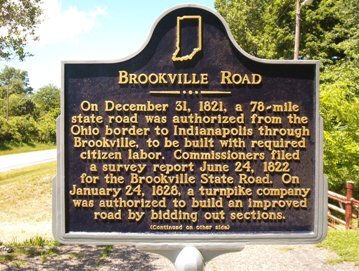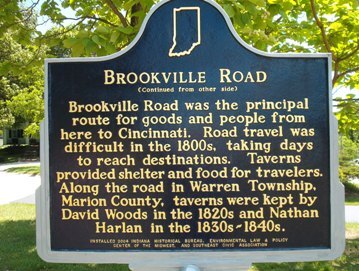

Location: 10622 Brookville Road, Indianapolis. (Marion County, Indiana)
Installed: 2004 Indiana Historical Bureau, Environmental Law & Policy Center of the Midwest, and Southeast Civic Association
ID# : 49.2004.1
Text
Side one:
On December 31, 1821, a 78-mile state road was authorized from the Ohio border to Indianapolis through Brookville, to be built with required citizen labor. Commissioners filed a survey report June 24, 1822 for the Brookville State Road. On January 24, 1828, a turnpike company was authorized to build an improved road by bidding out sections.
Side two:
Brookville Road was the principal route for goods and people from here to Cincinnati. Road travel was difficult in the 1800s, taking days to reach destinations. Taverns provided shelter and food for travelers. Along the road in Warren Township, Marion County, taverns were kept by David Woods in the 1820s and Nathan Harlan in the 1830s - 1840s.
Keywords
Transportation, Business, Industry, and Labor
Annotated Text
Side one:
On December 31, 1821, a 78-mile state road was authorized from the Ohio border to Indianapolis through Brookville, to be built with required citizen labor.(1) Commissioners filed a survey report June 24, 1822 for the Brookville State Road.(2) On January 24, 1828, a turnpike company was authorized to build an improved road by bidding out sections.(3)
Side two:
Brookville Road was the principal route for goods and people from here to Cincinnati.(4) Road travel was difficult in the 1800s, taking days to reach destinations.(5) Taverns provided shelter and food for travelers.(6) Along the road in Warren Township, Marion County, taverns were kept by David Woods in the 1820s(7) and Nathan Harlan in the 1830s - 1840s.(8)
Notes:
(1) The Brookville road was one of twenty-two authorized by the law. Laws of Indiana, 1821-22, pp. 152, 159. Commissioners for the state road were David Mount, Samuel Shirk, and John Davies. Ibid., 159. All state roads authorized in this act "to be opened forty-eight feet wide, and take off all timber even with the ground; except such as are eighteen inches and upwards, which shall be cut at the usual height of twelve inches." Ibid., 167. The act required all able-bodied male persons between the ages of eighteen and fifty years to work on public roads and highways; minimum working days for non-property owners were two days a year; work days required increased with the amount of property owned. Ibid., 38, 39, 42. The requirement for citizen labor on roads began as early as 1807; Francis S. Philbrick, ed., The Laws of Indiana Territory, 1801-1809 (reprint, Indianapolis, 1931), 427, 433, 439.
(2)"Marion County Commissioners' Report, Record Book 1, 1822-1827, " Indiana State Archives, 217. The Marion County portion was surveyed by W.B. Laughlin. Ibid.
(3) An Act to incorporate the Indianapolis and White Water Turnpike Company, " Laws of Indiana, 1828, p. 47, 48. The road was to be forty-eight foot wide, clear of all timber, and thirty feet of said road, at least in width and as near the center as may be, should be made an artificial clay turnpike; good and sufficient bridges over all rivers and creeks were required. Ibid., 47. Commissioners were David Tracy, Noah Noble, Job Pugh, and David Mount. Ibid., 47. Tolls gates were to be built every ten miles by the contractors. Ibid., 49. "Upon completion of contracts for their portion of the turnpike, the ‘undertakers' or contractors received certificates which could be transferred to others. When the turnpike was complete, holders of certificates were to become stockholders of the corporation" (the Indianapolis and White Water Turnpike Company). Donald F. Carmony, Indiana 1816-1850: The Pioneer Era (Indianapolis, 1998), 678, note 218.
(4)Indianapolis Democrat, August 1833; Brookville American, October 10, 1834, November 28, 1834; Emma S. Vonnegut, ed. and trans., "The Schramm Letters, " Indiana Historical Society Publications (Indianapolis, 1937) 11: 262, 264; Howard Johnson, A Home in the Woods: Oliver Johnson's Reminiscences of Early Marion County (Indianapolis, 1951), 219-20.
(5)Carmony, 38-39, 132-33. A trip to Cincinnati from Indianapolis on horseback in 1834, for example, took 2 days. "Transportation Developments in the Early Republic" accessed November 6, 2003.
(6)Johnson, 220-21; B. R. Sulgrove, History of Indianapolis and Marion County, Indiana (Philadelphia, 1884), 619.
(7)Sulgrove, 619. Woods' property was located in Warren Township in NW 1/4 Section 21, Township 15, Range 5. Thelma M. Murphy, "Marion County, Indiana Pioneers; Prior to June 1830, " typescript, Indiana State Library; "Names of Persons Enumerated in Marion County, Indiana at the Fifth Census [1830], " Indiana Historical Society Publications, vol. 4., no. 5. (Indianapolis, 1908), 355; Jane Eaglesfield Darlington, abstractor, "Marion County, Indiana, Complete Probate Records, January 1830-August 1852, " (September 1994), p. 2; Illustrated Historical Atlas of the State of Indiana (Chicago, 1876), 112. Woods died in October, 1831. Darlington, 2.
(8)Sulgrove, 615, 619. Harlan's property was located in Warren Township, Section 22, Township 15N, Range 5 East. Murphy; "Names of Persons, " 355; Historical Atlas, 1876, p. 112. Harlan took the contract for cutting timber from off the line of the Brookville Road in 1828. Sulgrove, 615. Harlan died October 26, 1846. Darlington, 211.
